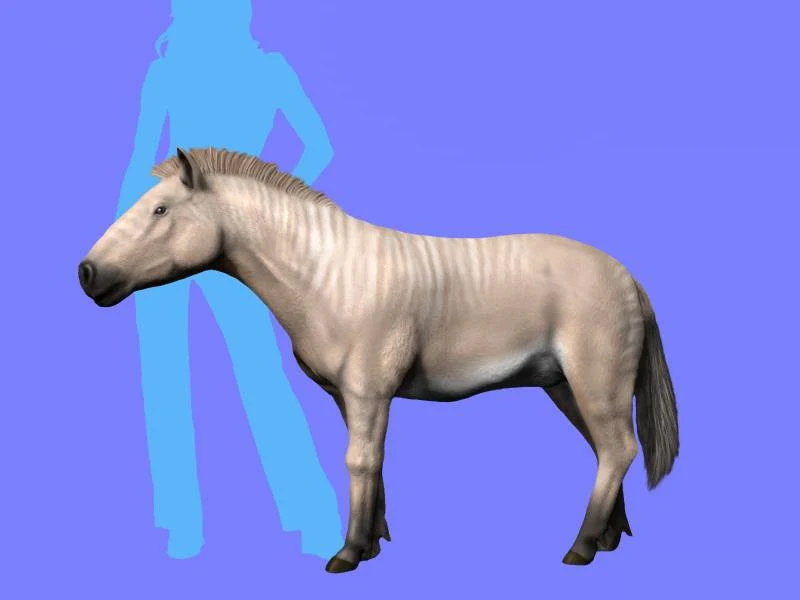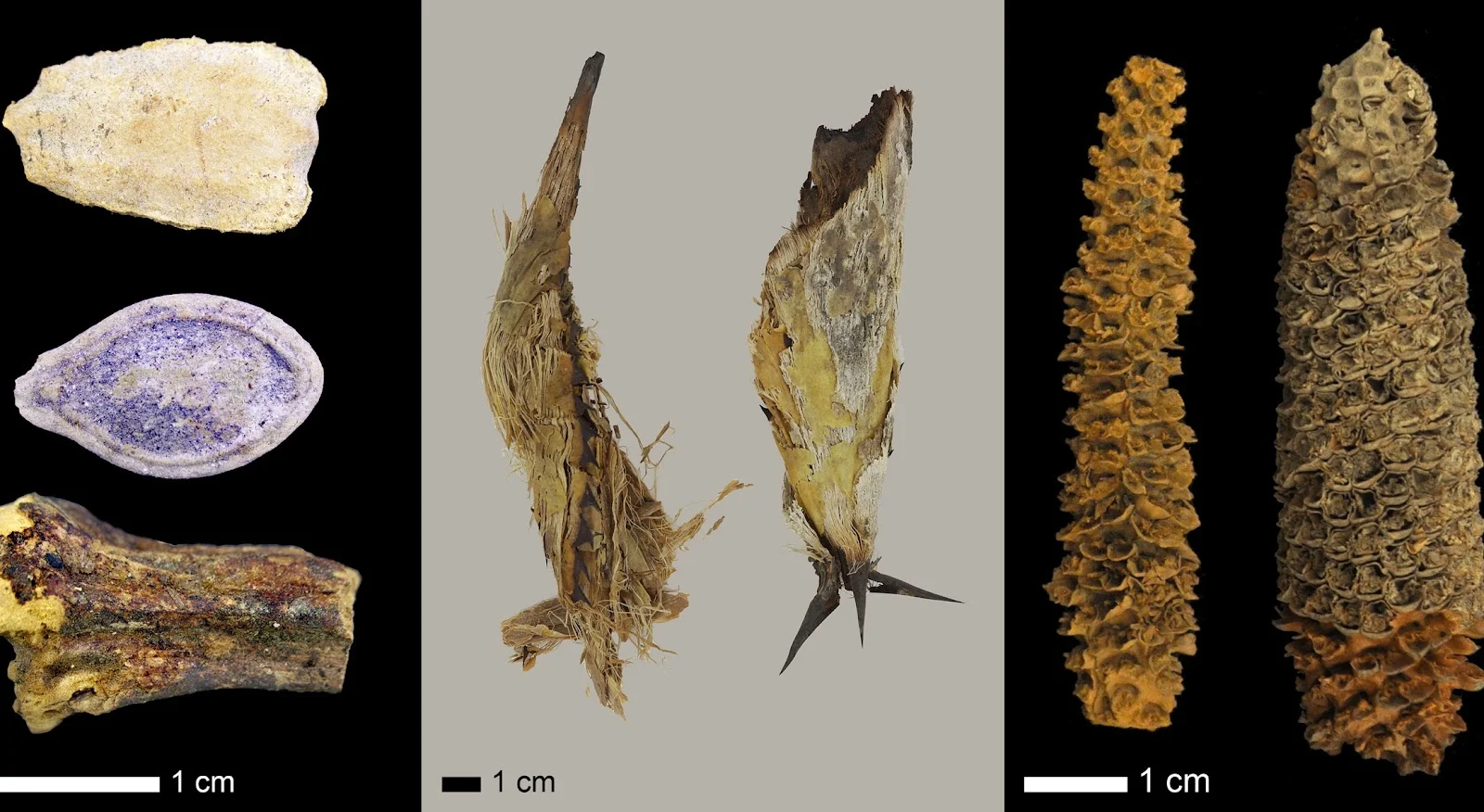Dawn Horse (artists impression)

Hipparion forcei (a relative of the Laetoli species)
While increasingly desperate creationist frauds continue to try to fool their followers into believing that biologists are about to abandon the Theory of Evolution in favour of their childish superstition based on unproven magical supernatural entities, real biologists are debating the minute details of how taxons like the equids (horses, donkeys, zebras, etc.) evolved.
One of the mysteries in the evolution of this order is what exactly happened to the lateral toes as the modern equid foot evolved from the common pattern found in ungulates (five at the front, four at the back) through three in extinct equids into a single hooved toe. A
recent paper in
Royal Society Open Science had suggested that, contrary to the earlier consensus, the toes had become fused into the single central toe with their hooves contributing to the structure of the single hoof with its underlying 'frog'. This had been based in part on an examination of 3.7-million-year-old hoof prints of extinct members of the three-toed
Hipparion genus found at Laetoli in the same volcanic ash deposits as those of the extinct bipedal hominid,
Australopithecus.
Now a new study disputes those findings and confirms the original hypothesis that, while the lateral upper bones of the digits did indeed fuse as 'splints' to the central digits, the lower bones (the 'fingers and toes') were simply lost. The research team was led by
Professor Alan R. Vincelette of Department of Pathology,
St. John's Seminary, Camarillo, CA, USA and included
Professor Christine Janis of the
School of Earth Science,
Bristol University, Bristol, UK.
The research is explained in a Bristol University news release:
The distant ancestors of modern horses had hooved toes instead of a single hoof, which vanished over time, according to researchers.

Plantar (underneath) view of feet of a four-toed tapir (left) and a one-toed horse (right) by Nuria Melisa Morales-García. In the middle, a reconstruction of the extinct three-toed horse Hipparion, by Karolina Suchan-Okulska.
Overall design: Morales-García.
In contrast, modern equids such as horses, asses, and zebras, have only a single toe, the left over original third toe on each foot, encased in a thick-walled keratinous hoof, with an underlying triangular frog on the sole that acts as a shock absorber.
An international team of scientists, from the UK, the US, and the Netherlands, analysed hoof prints and foot bones from modern horses and fossil records to discover what happened to the lost digits.
The upper portions – the remains of the additional hand and foot bones - remain as ‘splint bones’ fused with the remaining central one, but where are the fingers and toes?
In later fossil horses there were only three toes front and back. The extra toes, known as side toes, in these horses were smaller and shorter than in a tapir, and likely did not touch the ground under normal circumstances, but they may have provided support in exceptional situations, such as sliding or forceful impact.
While the notion that modern horses have retained all of their original toes as within-hoof remnants is a novel one, and so rather appealing, it can be shown to be incorrect.
Professor Christine Janis, co-author
School of Earth Sciences
University of Bristol, Bristol, UK.
Although it does seem that remainders of the proximal (upper portions) of the sider digits have been retained in modern horses, as the earlier 2018 paper claimed, the distal (lower portions, or toes) have simply been lost.
The frog of the horse's hoof evolved independently of the side toes as a unique structure providing shock absorption and traction during locomotion.
Professor Alan Vincelette, lead author
St. John’s Seminary, Camarillo, CA, USA
This was partially based on an interpretation of the hoof prints of an extinct three-toed horse, Hipparion (not on the direct line to modern horses) from Laetoli in Tanzania 3.7 million years ago, the same site that yielded the famous footprints of the hominid Australopithecus. These hoof prints apparently lacked a frog, and this added weight to the notion that the side toes of horses like Hipparion now contribute to the frog of modern horses.
While not all hoof prints of modern horses with frogs record its presence, an undoubted frog can be seen in many hoof prints that are known to have been made by three-toed horses. These observations cast doubt on the notion that the frog of modern horse hooves formed out of the side toes of tridactyl equids.
The team also show that the feet of one-toed horses have a different shape from the main toe of the foot of three-toed horses, being round rather than oval, a difference that may be related to differences in weight distribution and/or ecological habitat.

Copyright: © 2023 The authors.
Published by The Royal Society. Open access.
(CC BY 4.0)The abstract to the open access paper in Royal Society Open Science, has more technical details:
Abstract
The traditional story of the evolution of the horse (family Equidae) has been in large part about the evolution of their feet. How did modern horses come to have a single toe (digit III), with the hoof bearing a characteristic V-shaped keratinous frog on the sole, and what happened to the other digits? While it has long been known that the proximal portions of digits II and IV are retained as the splint bones, a recent hypothesis suggested that the distal portion of these digits have also been retained as part of the frog, drawing upon the famous Laetoli footprints of the tridactyl (three-toed) equid Hipparion as part of the evidence. We show here that, while there is good anatomical and embryological evidence for the proximal portions of all the accessory digits (i.e. I and V, as well as II and IV) being retained in the feet of modern horses, evidence is lacking for the retention of any distal portions of these digits. There is also good ichnological evidence that many tridactyl equids possessed a frog, and that the frog has been part of the equid foot for much of equid evolutionary history.
Vincelette, Alan R.; Renders, Elise; Scott, Kathleen M.; Falkingham, Peter L.; and Janis, Christine M. (2023)
Hipparion tracks and horses' toes: the evolution of the equid single hoof
R. Soc. open sci.; 10230358230358. DOI:10.1098/rsos.230358.

Copyright: © 2023 The authors.
Published by The Royal Society. Open access.
Reprinted under a
Creative Commons Attribution 4.0 International license (CC BY 4.0)
Yet another piece of biology refuting several basic creationists claims, and to make matters worse, one of the scientists, the leader of the team and lead author of the paper,
Professor Alan R. Vincelette, PhD, is a Catholic seminarian and a leading expert on the evolution of horses. He expresses no doubt at all that the TOE provides a complete explanation for the fossil record which shows the evolution of the equids over time.
But then, in mainstream Christianity, there is no problem at all with accepting the TOE. It's only the wackadoodle extremist fringe cults that requires their members to be fooled by falsehoods.
So, which creationist is going to explain to Professor Vincelette, PhD, why he is wrong, both in his theology and in his science?





























